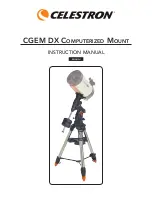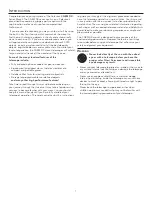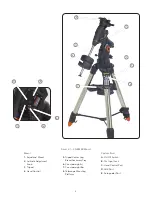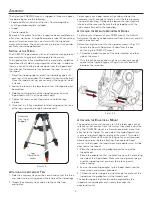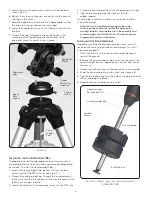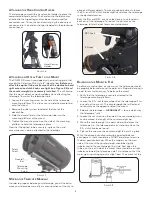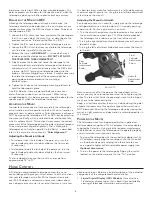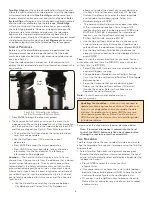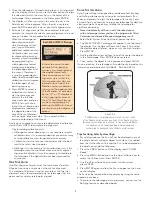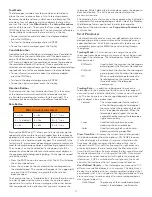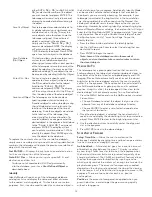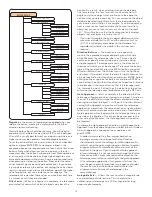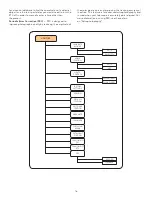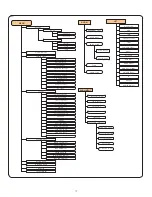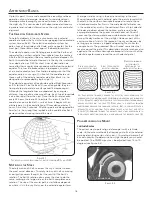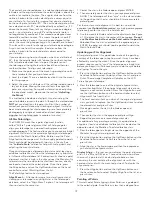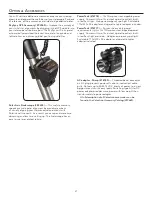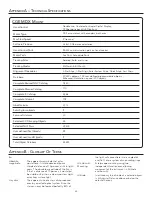
9
2 . Once the telescope is finished slewing to your first alignment
star, the display will ask you to use the arrow buttons to align
the selected star with the cross hairs in the center of the
finderscope . When centered in the finder, press ENTER .
3 . The display will then instruct you to center the star in the
field of view of the eyepiece . When the star is centered,
press ALIGN to accept this star as your first alignment star .
4 . After the first alignment star has been entered the hand
control will automatically select a second alignment star and
have you repeat this procedure for that star .
When the telescope has
been aligned on both
stars the display will ask
you if you wish to add
additional calibration stars.
Calibration stars are used
to improve the pointing
accuracy of your telescope
by compensating for
subtle opto-mechanical
misalignments between
the telescope optics and
the mount. Therefore it
is usually a good idea to
add at least one additional
calibration star to improve
the telescope’s all-sky
pointing accuracy.
5 . Press ENTER to select a
calibration star . Select a
star the same way you
did with the first two
alignments stars and pres
ENTER . You will notice
that all the calibration stars
displayed are located on
the opposite side of the
side of the sky (Meridian)
as the original alignment stars . This is essential for an
accurate calibration of the mount .
Finally you can chose to continue to add additional calibration
stars or Press UNDO to complete the alignment .
Tips for adding calibration stars:
• Although for casual observing it is not necessary to add
calibration stars, it is recommended that you add as many
as three calibration stars for optimal point accuracy.
• Calibration stars that are near the equator offer the best
results than stars near the poles.
• Although it is not necessary to use calibration stars if the
telescope mount has not been moved since its original
alignment/calibration, it may be necessary to recalibrate
the telescope if the optical tube has been removed for
any reason.
o
nE
S
tar
a
liGn
One-Star Alignment works much the same way as Two-Star
Align but uses only a single star in the sky for alignment .
This method of alignment is not as accurate as the two-star
alignment and is recommended only for telescopes that are
permanently and accurately polar aligned .
S
olar
S
yStEM
a
liGn
Solar System Align is designed to provide excellent tracking
and GoTo performance by using solar system objects (Sun,
Moon and planets) to align the telescope with the sky . Solar
System Align is a great way to align your telescope for daytime
viewing as well as a quick way to align the telescope for
nighttime observing .
Never look directly at the sun with the naked eye or
with a telescope (unless you have the proper solar filter).
Permanent and irreversible eye damage may result.
1 . Select Solar System Align from the alignment options .
2 . The SELECT OBJECT message will appear in the top row of
the display . Use the Up and Down scroll keys (10) to select
the daytime object (planet, moon or sun) you wish to align .
Press ENTER .
3 . Use the direction arrow buttons to carefully center the object
in the finderscope . Press ENTER when centered .
4 . Then, center the object in the eyepiece and press ALIGN .
Once in position, the telescope will model the sky based on this
information and display
Alignment Successful
.
Tips for Using Solar System Align
• For safety purposes, the Sun will not be displayed in any of
the hand control’s customer object lists unless it is enabled
from the Utilities Menu . To allow the Sun to be displayed on
the hand control, do the following:
1 . Press the UNDO button until the display reads “CGEM
Ready”
2 . Press the MENU button and use the Up and Down keys to
select the
Utilities menu
. Press ENTER .
3 . Use the UP and Down keys to select
Sun Menu
and
press ENTER .
4 . Press ENTER again to allow the Sun to appear on the hand
control display .
The Sun can be removed from the display by using the same
procedure as above .
• To improve the telescope pointing accuracy, you can use the
Re-Align feature as described below .
East/West (E/W) Filtering
In order to ensure the best
possible full sky pointing
accuracy, your computerized
telescope automatically
filters and chooses its initial
alignment stars so that the
first two alignment stars are
located on one side of the
Meridian and any calibration
stars are on the opposite side
of the Meridian, as indicated
by the “W” or “E” displayed
in the upper-right corner of
the LCD. East/West filtering
can be changed simply by
pressing the MENU button at
any time during the alignment
process.
F
igure
3-3
t
he
M
eriDian
is
an
iMaginary
line
in
the
sky
that
starts
at
the
n
orth
Celestial
Pole
anD
enDs
at
the
s
outh
Celestial
Pole
anD
Passes
through
the
zenith
. i
F
you
are
FaCing
s
outh
,
the
MeriDian
starts
FroM
your
s
outhern
horizon
anD
Passes
DireCtly
overheaD
to
the
n
orth
Celestial
Pole
.
Содержание CGEM DX
Страница 1: ...INSTRUCTION MANUAL CGEM DX Computerized Mount ENGLISH...
Страница 29: ...27 Appendix D Maps Of Time Zones...
Страница 30: ...28...
Страница 31: ...29 Sky Maps...
Страница 32: ...30...
Страница 33: ...31...
Страница 34: ...32...
Страница 35: ...33...
Страница 36: ...34...

